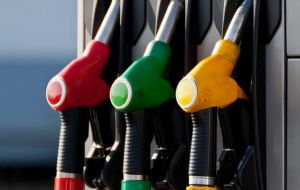MercoPress. South Atlantic News Agency
When talking fuel, Mexico and Argentina the better off; Colombia and Uruguay bottom of the list
 An average salary in Mexico is equivalent to 1.057 liters of fuel; in Uruguay, 376 liters
An average salary in Mexico is equivalent to 1.057 liters of fuel; in Uruguay, 376 liters Taking as reference the ratio between the average salary and the price of gasoline in six Latam countries, Mexican and Argentine consumers are the better off when it comes to filling up the tank while for Uruguay and Colombia the ratio is the least favorable.
In effect despite the latest 7% price increase for fuels in Argentina, taking the average monthly salary regularly published by the stats office Indec, which is 7.722 Pesos and if is divided by the price of the cheapest fuel (95 octane), the result is 885 liters. However if the fuel purchased is 97 octane, the result is 796 liters.
In Mexico the ratio result is even better: with the average monthly salary at 12.708 Pesos and the liter of gasoline 95 octane at 12.02 Pesos, Mexicans can purchase 1.057 liters.
In Chile the liter of gasoline, 93 octane, costs on average 750 Chilean Pesos according to the Consumers' Office, while the average monthly salary is estimated at 539.800 Pesos which means the equivalent of 750 liters.
In Brazil, gasoline at the pump costs 2.68 Real in Sao Paulo according to the Petroleum Agency oil, gas and bio-fuel survey. The average monthly salary is estimated by the stats office Ibope at 1.792 Real, which results in 668 liters.
Finally the two countries where consumers face a tighter equation are Uruguay and Colombia. In Uruguay the cost of gasoline is 40.6 Pesos and the average monthly salary is estimated in 15.000 Pesos, which works out at 376 liters, or a third of what a Mexican can purchase or half of neighboring Argentina.
In Colombia a liter of gasoline, 83 octane, costs 2.187 Pesos in Bogotá the capital, and the 88 octane, 2.753 Pesos (1.43 US dollars). The average salary according to ILO (International Labor Organization) stands at 1.241.000 Pesos, which works out at 567 liters.
It must be added that Uruguay imports all of its crude to refine into fuel, and also heavily taxes gasoline which costs almost 2 dollars a liter.
Likewise Venezuela has not been included in the list because the gasoline price is ridiculous low, which costs the treasury over 15bn dollars annually and the government is preparing to announce a new pricing system.




Top Comments
Disclaimer & comment rules-

-

-

Read all commentsDoesn't sound like a bad thing.
Jan 08th, 2014 - 09:40 am 0Promotes fuel efficiency and alternatives. As well as bolsters public transport usage instead of car ownership.
@ 1 Anglotino
Jan 08th, 2014 - 11:07 am 0I have to disagree with you this time (the first I think) but this damaging cost of fuel does not encourage public transport per se because the transport is overpriced due to the cost of the fuel, which is not only taxed as an item in its own right it has IVA added to everything, including the tax.
Transport of goods in Uruguay is by road, there are no goods trains. I think the technology and cost of operation defeated successive administrations.
Anything with four wheels commands ridiculous prices because of the need for families to have transport. A 14 YO Citroen Saxo diesel was at the side of the road in Montevideo this week with a US$ 6,500 price tag on it. I have no doubt the owner will get that.
So yes, the green agenda sounds nice when you live in a modern country like Oz and have a lot of money. Try Uruguay on a basic workers pay and see how far you get.
The last rise of 10% (inc IVA) was a Pepe special. It seems even the head of ANCAP (the monopoly fuel supplier) did not know until Pepe dropped it out in passing when he was somewhere (not in the Administration Building).
“Green agenda” by the sound of it (Octane) they are still using leaded petrol.
Jan 08th, 2014 - 04:12 pm 0Converting to un-leaded, with engines designed for it, would increase the fuel efficiency of vehicles by 25-30% for a start.
Commenting for this story is now closed.
If you have a Facebook account, become a fan and comment on our Facebook Page!